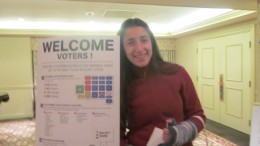I spent the day with my mom, who had to walk from polling place to polling place. She has the job of Polling Place Inspector. As we walked in between, we had a banner, balloons, and "I Voted Today" stickers to hand out to people. It was a lot of fun. I got a few interviews, some of them videotaped. My computer isn't cooperating with me, however, so here are the various answers people gave to the various questions:
1. What motivated you to come out and vote?
--"I'm a citizen, and voting gives me the right to complain."
--"My husband does, and I help him at the polls."
--"Civic duty"
2. Do you vote every election?
--"I would like to see a bit of cooperation in the senate, and I'd like to see the country moving forward. I would like to see campaigns that are focused on the issues as opposed to personality - I think this year has been among the worst in memory in terms of negative campaigns, and as a citizen, I am disgusted."
3. Do you vote in every election?
--Everyone answered yes.
4. Do you know why we vote on Tuesday?
--Everyone answered no.
5. Where have you encountered the highest amount of ad campaigning?
--Everyone answered the same: "television."
6. What was the most memorable campaign ad that you have encountered?
--"Onoroto - because of his face. He said his name a way no one else did. Aside from that, a murky blur of mud. They all have the same attacking formula. It shouldn't be so personal - it's been made into a personal thing. To antagonize people and direct so much negative energy into the campaign ordeal changes the environment. The whole point is that we're trying to work together. Every campaign is like, 'this guy said he was for this thing. But he's not, he's a bad person.' It's like a judgement."
--"Positive memory: Sestak's dog, the one with his dog. Negative memory: everything Toomey's done, including his face."
--"Obama's whole campaign because I never thought I'd see that happen."
7. Are you always sure of who you are going to vote for when you walk into the booth?
--Everyone answered yes.
8. What changes do you hope to see in Philadelphia (not necessarily as a result of this election, but maybe.)
--"I want the city to get cleaner."
9. What impact do you feel that your vote will have on the election?
--"It can't hurt!"
10. Did you learn about voting in school? Did that impact how you feel about voting?
--"No, I didn't - and that impacted my willingness to vote. You can't really issue your opinion if you're uneducated. You have to be aware of how the system works and what problems are even present to begin to address them. So everything I didn't learn in high school - I was pretty disappointed in how much I didn't know about the politicians and their policies. That made me want to get more involved because there are so many people in my position who aren't educated when it comes to politics and government."
--"No, but I don't wish I did. Voting is disappointing - either my side looses, or my side wins and doesn't do everything I wish they would."
--"Yes, but it didn't really have an impact."
While I did not get pictures of myself with balloons or posters (in retrospect, that would have been funny), here are some photos from the day:

Because four different divisions vote in the same place at my local polling place, there is a sign directing people where to go depending on where they live. There's even a nice little map!

Here's a screenshot from the video I took while interviewing two poll workers for a division close to my house. The woman on the left is the mother of Hannah Feldman! If you look closely, you can see the "I Voted Today" stickers they both have on. My mom gave those stickers to a lot of different polling places in her ward, and we gave out even more when we were walking around.

Outside the polling place, lots of signs. It's inside because the entire polling place is located in the Warwick hotel, on the third floor. Those signs are on the third floor, but only right out side the elevators - not down the hall towards where people vote.
